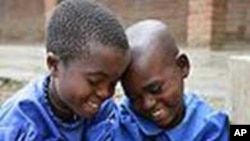Today, more than one-billion people have no access to safe drinking water. Two-and-a-half billion people lack access to improved sanitation. Each year some one-million-eight-hundred-thousand people - ninety-percent of them children under five - die from preventable diarrheal disease. Improving water supplies, sanitation, and hygiene are essential to upgrading public health in the developing world. And the U.S. is making a considerable effort to do just that.
The U.S. State Department released its third annual report to Congress on water and sanitation strategy in developing countries. The report is required by a law enacted in 2005 making the provision of safe water and sanitation services in developing countries a component of U.S. foreign assistance.
During fiscal year 2007 the United States obligated more than two-billion-four-
hundred-million dollars in support of water activities
worldwide. More than nine-hundred-million dollars of this support
funded water and sanitation-related activities in developing countries,
not including Iraq. As a result of these investments, millions of
people have gained improved access to safe drinking water and
sanitation. Water resources are being managed more wisely and more
productively. And many countries and communities are enjoying greater
water security. In addition, nearly two million people gained
first-time access to an improved water source. More than one-and-a-half
million people gained first-time access to basic sanitation.
Combined support from the U.S. Agency for International Development
andtheMillennium Challenge Corporation for drinking water,
sanitation, and hygiene activities exceeded five-hundred-ninety million
dollars in fiscal year 2007. In fiscal year 2008, USAID support for
drinking water supply, sanitation, and hygiene activities will likely
exceed three-hundred-million dollars.
In fiscal year 2007, U.S. assistance helped provide better water, sanitation, and hygiene in more than fifty countries around the world. It funded water treatment in Kenya, Madagascar, Malawi, Rwanda, and Zambia. It helped Bangladesh build new and rehabilitate existing water sources, providing safe drinking water for more than eight- hundred-thousand people. It built and provided technical assistance for water and sanitation infrastructure in Jordan, improving access to drinking water for some two-million people.
The global water challenge remains daunting, particularly in sub-Saharan Africa. The United States Government offers its experience and resources in support of efforts by committed countries to help achieve a water secure world with sustainable quantities and quality of water to meet human, economic, and ecosystem needs.





